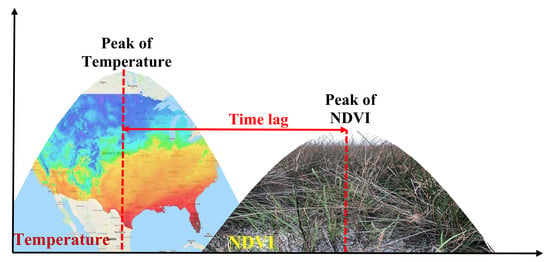Wetland Dynamics Inferred from Spectral Analyses of Hydro-Meteorological Signals and Landsat Derived Vegetation Indices
Abstract
:1. Introduction
2. Data and Methods
2.1. Site Description and Coastal Wetlands Classification
2.2. Forcing and Response Signals
2.3. Methodology
2.3.1. Power Spectral Density and Scaling Behavior in the Frequency Domain
2.3.2. Cross-Spectrum and Time-Lag Analysis Between Signals in the Frequency Domain
3. Results
4. Discussion
5. Summary and Conclusions
Author Contributions
Funding
Acknowledgments
Conflicts of Interest
References
- La Cecilia, D.; Toffolon, M.; Woodcock, C.E.; Fagherazzi, S. Interactions between river stage and wetland vegetation detected with a Seasonality Index derived from LANDSAT images in the Apalachicola delta, Florida. Adv. Water Resour. 2016, 89, 10–23. [Google Scholar] [CrossRef] [Green Version]
- Clinton, N.; Yu, L.; Fu, H.; He, C.; Gong, P. Global-scale associations of vegetation phenology with rainfall and temperature at a high spatio-temporal resolution. Remote Sens. 2014, 6, 7320–7338. [Google Scholar] [CrossRef] [Green Version]
- Van Hoek, M.; Jia, L.; Zhou, J.; Zheng, C.; Menenti, M. Early drought detection by spectral analysis of satellite time series of precipitation and Normalized Difference Vegetation Index (NDVI). Remote Sens. 2016, 8, 422. [Google Scholar] [CrossRef] [Green Version]
- Bilskie, M.V.; Hagen, S.C.; Alizad, K.; Medeiros, S.C.; Passeri, D.L.; Needham, H.F.; Cox, A. Dynamic simulation and numerical analysis of hurricane storm surge under sea level rise with geomorphologic changes along the northern Gulf of Mexico. Earth’s Future 2016, 4, 177–193. [Google Scholar] [CrossRef] [Green Version]
- Passeri, D.L.; Hagen, S.C.; Plant, N.G.; Bilskie, M.V.; Medeiros, S.C.; Alizad, K. Tidal hydrodynamics under future sea level rise and coastal morphology in the Northern Gulf of Mexico. Earth’s Future 2016, 4, 159–176. [Google Scholar] [CrossRef] [Green Version]
- Sivaperuman, C.; Venkatraman, C. Marine Faunal Diversity in India; Academic Press: Cambridge, MA, USA, 2015. [Google Scholar] [CrossRef]
- Barbier, E. Valuing ecosystem services for coastal wetland protection and restoration: Progress and challenges. Resources 2013, 2, 213–230. [Google Scholar] [CrossRef] [Green Version]
- Wamsley, T.V.; Cialone, M.A.; Smith, J.M.; Atkinson, J.H.; Rosati, J.D. The potential of wetlands in reducing storm surge. Ocean Eng. 2010, 37, 59–68. [Google Scholar] [CrossRef]
- Wong, C.P.; Jiang, B.; Bohn, T.J.; Lee, K.N.; Lettenmaier, D.P.; Ma, D.; Ouyang, Z. Lake and wetland ecosystem services measuring water storage and local climate regulation. Water Resour. Res. 2017, 53, 3197–3223. [Google Scholar] [CrossRef] [Green Version]
- Papa, F.; Prigent, C.; Durand, F.; Rossow, W.B. Wetland dynamics using a suite of satellite observations: A case study of application and evaluation for the Indian Subcontinent. Geophys. Res. Lett. 2006, 33. [Google Scholar] [CrossRef]
- Tadesse, T.; Demisse, G.B.; Zaitchik, B.; Dinku, T. Satellite-based hybrid drought monitoring tool for prediction of vegetation condition in Eastern Africa: A case study for Ethiopia. Water Resour. Res. 2014, 50, 2176–2190. [Google Scholar] [CrossRef]
- Rodgers, J.C.; Murrah, A.W.; Cooke, W.H. The impact of hurricane katrina on the coastal vegetation of the weeks bay reserve, alabama from NDVI data. Estuaries Coasts 2009, 32, 496–507. [Google Scholar] [CrossRef]
- Steyer, G.D.; Couvillion, B.R.; Barras, J.A. Monitoring vegetation response to episodic disturbance events by using multitemporal vegetation indices. J. Coast. Res. 2013, 63, 118–130. [Google Scholar] [CrossRef]
- Guo, M.; Li, J.; Sheng, C.; Xu, J.; Wu, L. A review of wetland remote sensing. Sensors 2017, 17, 777. [Google Scholar] [CrossRef] [PubMed] [Green Version]
- Tahsin, S.; Medeiros, S.C.; Singh, A. Resilience of coastal wetlands to extreme hydrologic events in Apalachicola Bay. Geophys. Res. Lett. 2016, 43, 7529–7537. [Google Scholar] [CrossRef]
- Kayastha, N.; Thomas, V.; Galbraith, J.; Banskota, A. Monitoring wetland change using inter-annual landsat time-series data. Wetlands 2012, 32, 1149–1162. [Google Scholar] [CrossRef]
- Maignan, F.; Bréon, F.M.; Bacour, C.; Demarty, J.; Poirson, A. Interannual vegetation phenology estimates from global AVHRR measurements. Comparison with in situ data and applications. Remote Sens. Environ. 2008, 112, 496–505. [Google Scholar] [CrossRef]
- Zhou, L.; Tucker, C.J.; Kaufmann, R.K.; Slayback, D.; Shabanov, N.V.; Myneni, R.B. Variations in northern vegetation activity inferred from satellite data of vegetation index during 1981 to 1999. J. Geophys. Res. Atmos. 2001, 106, 20069–20083. [Google Scholar] [CrossRef]
- Myneni, R.B.; Keeling, C.D.; Tucker, C.J.; Asrar, G.; Nemani, R.R. Increased plant growth in the northern high latitudes from 1981 to 1991. Nature 1997, 386, 698–702. [Google Scholar] [CrossRef]
- Kirilenko, A.P.; Sedjo, R.A. Climate change impacts on forestry. Proc. Natl. Acad. Sci. USA 2007, 104, 19697–19702. [Google Scholar] [CrossRef] [Green Version]
- Foley, J.A.; Kutzbach, J.E.; Coe, M.T.; Levis, S. Feedbacks between climate and boreal forests during the Holocene epoch. Nature 1994, 371, 52. [Google Scholar] [CrossRef]
- Telesca, L.; Lasaponara, R. Quantifying intra-annual persistent behaviour in SPOT-VEGETATION NDVI data for Mediterranean ecosystems of southern Italy. Remote Sens. Environ. 2006, 101, 95–103. [Google Scholar] [CrossRef]
- Feder, J. Fractals; Springer: Berlin/Heidelberg, Germany, 1988; ISBN1 978-1-4899-2126-0. ISBN2 978-1-4899-2124-6. [Google Scholar] [CrossRef]
- Zheng, H.; Song, W.; Satoh, K. Detecting long-range correlations in fire sequences with Detrended fluctuation analysis. Phys. A Stat. Mech. Its Appl. 2010, 389, 837–842. [Google Scholar] [CrossRef]
- Maktav, D. Remote sensing for a changing Europe. In Proceedings of the 28th Symposium of the European Association of Remote Sensing Laboratories, Istanbul, Turkey, 2–5 June 2008; IOS Press: Amsterdam, The Netherlands, 2009. ISBN 978-1-58603-986-8. [Google Scholar]
- Witt, A.; Malamud, B.D. Quantification of long-range persistence in geophysical time series: Conventional and benchmark-based improvement techniques. Surv. Geophys. 2013, 34, 541–651. [Google Scholar] [CrossRef] [Green Version]
- Switzer, T.S.; Winner, B.L.; Dunham, N.M.; Whittington, J.A.; Thomas, M. Influence of sequential hurricanes on nekton communities in a southeast Florida estuary: Short-term effects in the context of historical variations in freshwater inflow. Estuaries Coasts 2006, 29, 1011–1018. [Google Scholar] [CrossRef]
- Ramsey, E.W., III; Nelson, G.A.; Sapkota, S.K. Coastal change analysis program implemented in Louisiana. J. Coast. Res. 2001, 17, 53–71. [Google Scholar]
- Tahsin, S.; Medeiros, S.C.; Hooshyar, M.; Singh, A. Optical cloud pixel recovery via machine learning. Remote Sens. 2017, 9, 527. [Google Scholar] [CrossRef] [Green Version]
- Savitzky, A.; Golay, M.J.E. Smoothing and differentiation of data by simplified least squares procedures. Anal. Chem. 1964, 36, 1627–1639. [Google Scholar] [CrossRef]
- Chen, J.; Jönsson, P.; Tamura, M.; Gu, Z.; Matsushita, B.; Eklundh, L. A simple method for reconstructing a high-quality NDVI time-series data set based on the Savitzky-Golay filter. Remote Sens. Environ. 2004, 91, 332–344. [Google Scholar] [CrossRef]
- Luo, J.; Ying, K.; Bai, J. Savitzky-Golay smoothing and differentiation filter for even number data. Signal Process. 2005, 85, 1429–1434. [Google Scholar] [CrossRef]
- Tahsin, S.; Medeiros, S.C.; Singh, A. Assessing coastal wetland resiliency to extreme events using remote sensing. Remote Sens. 2018, 10, 1390. [Google Scholar] [CrossRef] [Green Version]
- Singh, A.; Guala, M.; Lanzoni, S.; Foufoula-Georgiou, E. Bedform effect on the reorganization of surface and subsurface grain size distribution in gravel bedded channels. Acta Geophys. 2012, 60, 1607–1638. [Google Scholar] [CrossRef]
- Stoica, P.; Randolph, L.M. Introduction to Spectral Analysis; Prentice Hall: Upper Saddle River, NJ, USA, 1997; Volume 1. [Google Scholar]
- Stull, R.B. An Introduction to Boundary Layer Meteorology; Springer Science+Business Media: Medford, MA, USA, 2012; Volume 13. [Google Scholar]
- Gardner, W.A. Statistical spectral analysis: A nonprobabilistic theory. Technometrics 1986, 34, 109–110. [Google Scholar] [CrossRef] [Green Version]
- Keylock, C.J.; Singh, A.; Foufoula-Georgiou, E. The complexity of gravel bed river topography examined with gradual wavelet reconstruction. J. Geophys. Res. Earth Surf. 2014, 119, 682–700. [Google Scholar] [CrossRef] [Green Version]
- Singh, A.; Lanzoni, S.; Wilcock, P.R.; Foufoula-Georgiou, E. Multiscale statistical characterization of migrating bed forms in gravel and sand bed rivers. Water Resour. Res. 2011, 47. [Google Scholar] [CrossRef] [Green Version]
- Pilgram, B.; Kaplan, D.T. A comparison of estimators for 1/f noise. Phys. D Nonlinear Phenom. 1998, 114, 108–122. [Google Scholar] [CrossRef]
- Hansen, A.; Singh, A. High-frequency sensor data reveal across-scale nitrate dynamics in response to hydrology and biogeochemistry in intensively managed agricultural basins. J. Geophys. Res. Biogeosci. 2018, 123, 2168–2182. [Google Scholar] [CrossRef]
- Bak, P.; Tang, C.; Wiesenfeld, K. Self-organized criticality: An explanation of the 1/f noise. Phys. Rev. Lett. 1987, 59, 381. [Google Scholar] [CrossRef]
- Mandelbrot, B.B.; Ness, V. Fractional Brownian motions, fractional noises and applications. SIAM Rev. 1968, 10, 422–437. [Google Scholar] [CrossRef]
- Malamud, B.D.; Turcotte, D.L. Self-affine time series: I. Generation and analyses. Adv. Geophys. 1999, 40, 1–90. [Google Scholar] [CrossRef]
- Mandelbrot, B.B. The fractal geometry of nature. Am. Math. Mon. 1984, 91, 594–598. [Google Scholar] [CrossRef]
- Holden, G.J. Gauging the fractal dimension of response times from fractal geometry. In Contemporary Nonlinear Methods for Behavioral Scientists: A Webbook Tutorial; 2005. Available online: WWW.NSF.GOV/SBE/BCS/PAC/NMBS/NMBS.J (accessed on 16 September 2019).
- Hurricane Research Division. Chronological List of All Hurricanes which Affected the Continental United States: 1851–2012. Available online: https://web.archive.org/web/20140210221648/http://www.aoml.noaa.gov/hrd/hurdat/All_U.S._Hurricanes.html (accessed on 23 October 2018).
- Yang, L.; Homer, C.; Hegge, K.; Huang, C.; Wylie, B.; Reed, B. A Landsat 7 scene selection strategy for a National Land Cover Database. In Proceedings of the IEEE 2001 International Geoscience and Remote Sensing Symposium (Catalogue No. 01CH37217), Sydney, Ausralia, 9–13 July 2001; Volume 3, pp. 1123–1125. [Google Scholar]
- Conner, W.; Buford, M.A. Southern Forested Wetlands; Messina, M.G., Conner, W.H., Eds.; CRC Press LLC: Boca Raton, FL, USA; Boston, MA, USA; New York, NY, USA; Washington, DC, USA; London, UK, 1998; ISBN l-56670-228-3. [Google Scholar]
- Holling, C.S. Resilience and stability of ecological systems. Annu. Rev. Ecol. Syst. 1973, 4, 1–23. [Google Scholar] [CrossRef] [Green Version]
- Gunderson, L.H. Ecological resilience—In theory and application. Annu. Rev. Ecol. Syst. 2002, 31, 425–439. [Google Scholar] [CrossRef] [Green Version]
- Perkins, P.; Heber, S. Identification of ribosome pause sites using a Z-score based peak detection algorithm. In Proceedings of the IEEE 8th International Conference on Computational Advances in Bio and Medical Sciences (ICCABS), Las Vegas, NV, USA, 18–20 October 2018; pp. 1–6, ISBN 978-1-5386-8520-4. [Google Scholar]
- Lo, O.; Buchanan, W.J.; Griffiths, P.; Macfarlane, R. Distance measurement methods for improved insider threat detection. Secur. Commun. Netw. 2018, 2018, 5906368. [Google Scholar] [CrossRef]
- Moore, J.; Goffin, P.; Meyer, M.; Lundrigan, P.; Patwari, N.; Sward, K.; Wiese, J. Managing in-home environments through sensing, annotating, and visualizing air quality data. Proc. ACM Interact. Mob. Wearable Ubiquitous Technol. 2018, 2, 128. [Google Scholar] [CrossRef] [Green Version]
- Lizárraga-Celaya, C.; Watts, C.J.; Rodríguez, J.C.; Garatuza-Payán, J.; Scott, R.L.; Sáiz-Hernández, J. Spatio-temporal variations in surface characteristics over the North American Monsoon region. J. Arid Environ. 2010, 74, 540–548. [Google Scholar] [CrossRef]
- Vivoni, E.R.; Moreno, H.A.; Mascaro, G.; Rodriguez, J.C.; Watts, C.J.; Garatuza-Payan, J.; Scott, R.L. Observed relation between evapotranspiration and soil moisture in the North American monsoon region. Geophys. Res. Lett. 2008, 35. [Google Scholar] [CrossRef] [Green Version]
- Notaro, M.; Liu, Z.; Gallimore, R.G.; Williams, J.W.; Gutzler, D.S.; Collins, S. Complex seasonal cycle of ecohydrology in the Southwest United States. J. Geophys. Res. Biogeosci. 2010, 115. [Google Scholar] [CrossRef]
- Dinerstein, E.; Weakley, A.; Noss, R.; Snodgrass, R.; Wolfe, K. Florida Sand Pine Scrub. Available online: https://www.worldwildlife.org/ecoregions/na0513 (accessed on 19 Feburary 2019).
- Adam, P. Saltmarsh Ecology; Cambridge University Press: Cambridge, UK, 1990; ISBN 0-521-24508-7. [Google Scholar]
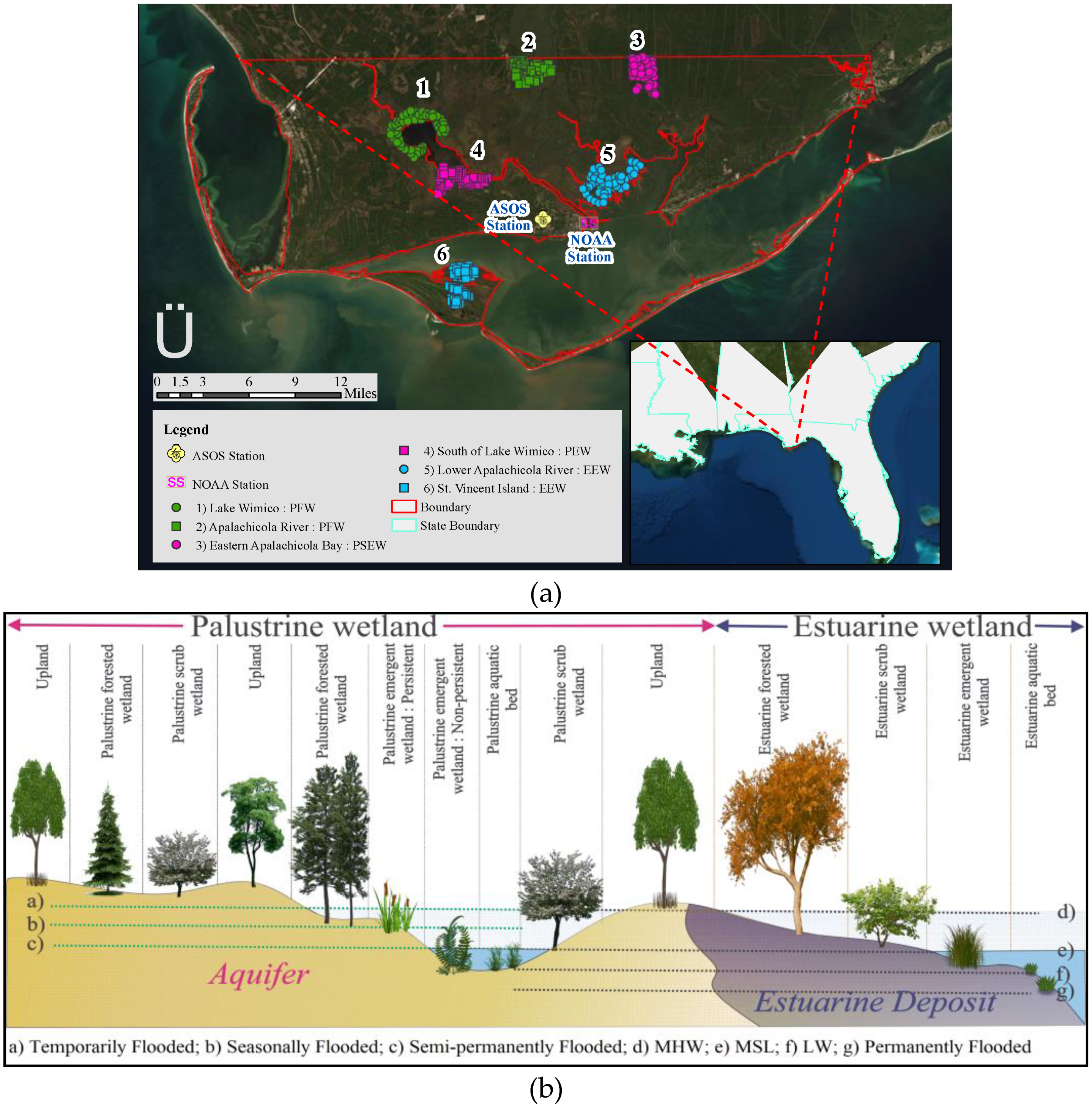
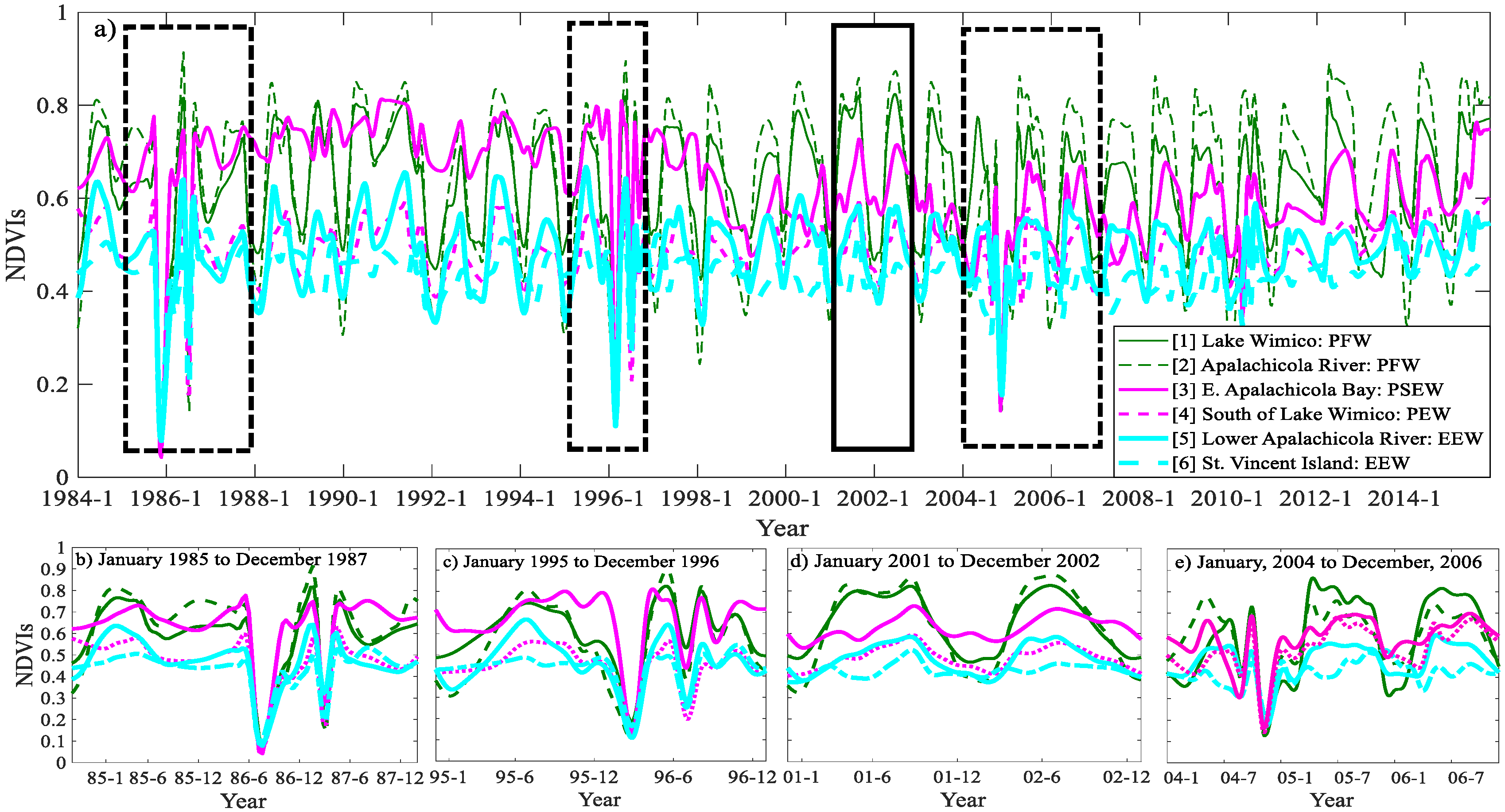
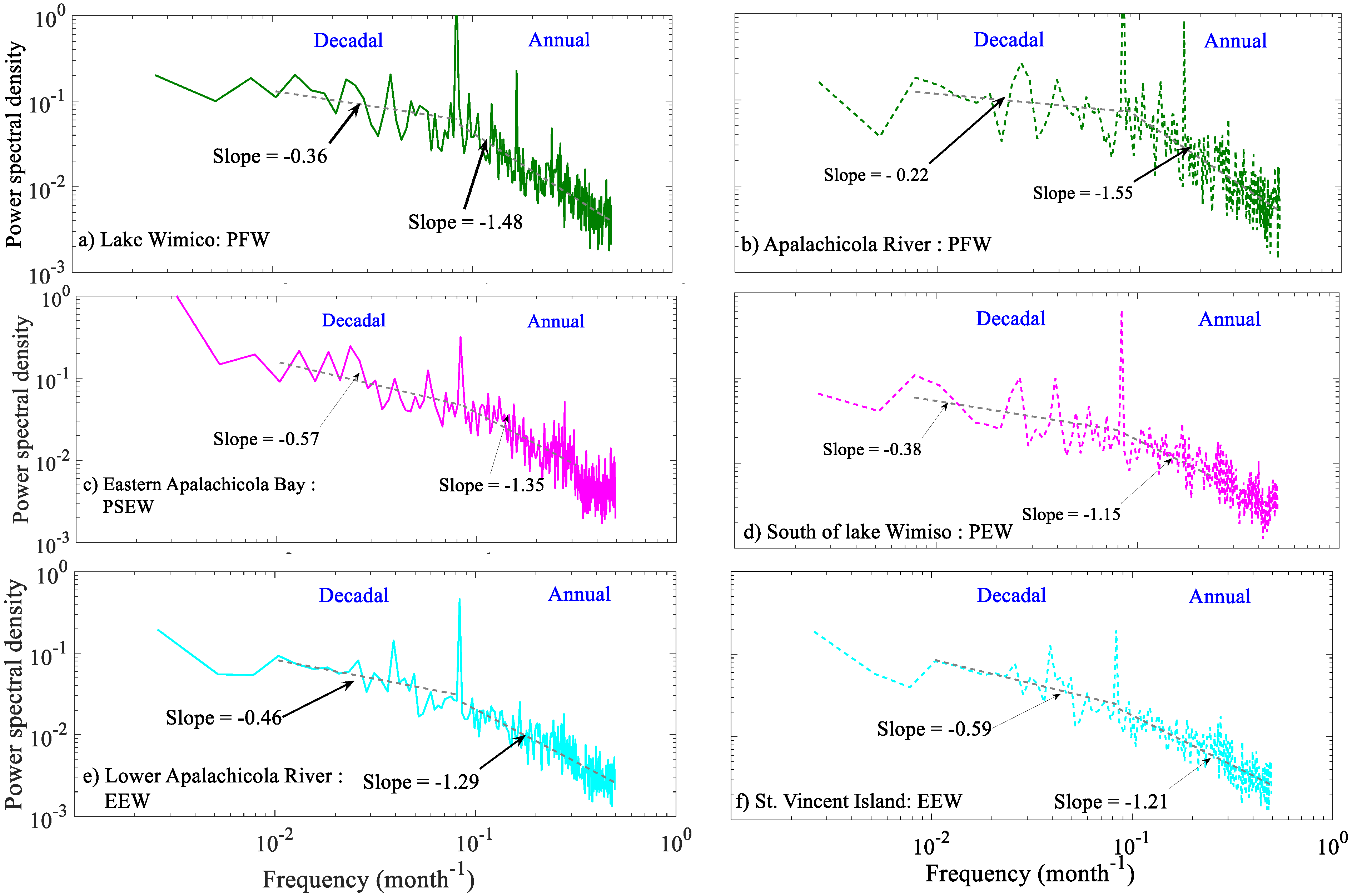

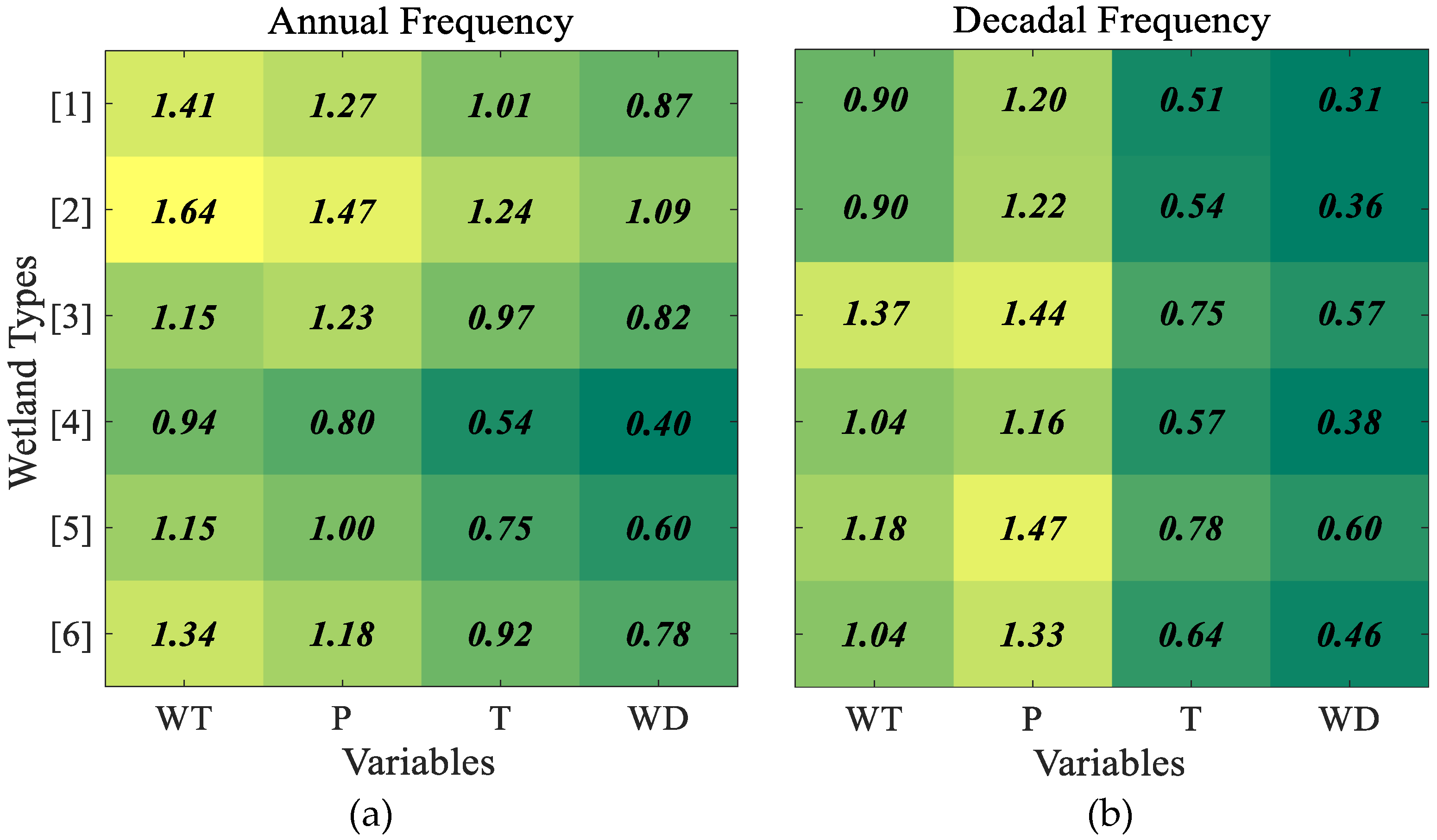
| Cross Power Spectral Density (CPSD) Variables | (Major Peak) % of Amplitude at Annual Frequency | Phase-Lag (Degree) | Time-Lag (Months) | (Minor Peak) % of Amplitude at Other Frequencies |
|---|---|---|---|---|
| Wet 1 vs. temperature | 31.6 | 81.9 | 2.7 | 1.0 [Every 1.2 years] |
| Wet 2 vs. temperature | 39.5 | 62.3 | 2.1 | 0.7 [Every 8 years] |
| Wet 3 vs. temperature | 22.0 | 24.5 | 0.8 | No minor peak |
| Wet 4 vs. temperature | 32.6 | 32.0 | 1.1 | 0.5 [Every 8 years] |
| Wet 5 vs. temperature | 37.4 | 56.2 | 1.9 | No minor peak |
| Wet 6 vs. temperature | 16.7 | 50.8 | 1.7 | 1.0 [Every 6 years] |
| Wet 1 vs. water level | 11.2 | 66.0 | 2.2 | 2.3 [Every 5 years] |
| Wet 2 vs. water level | 19.1 | 46.6 | 1.6 | 2.3 [Every 8 years] |
| Wet 3 vs. water level | 16.1 | 39.7 | 1.3 | 2.1 [Every 1.6 years] |
| Wet 4 vs. water level | 15.7 | 26.3 | 0.9 | 1.6 [Every 5 years] |
| Wet 5 vs. water level | 17.5 | 46.6 | 1.6 | No minor peak |
| Wet 6 vs. water level | 14.1 | 41.8 | 1.4 | 1.4 [Every 2 years] |
| Wet 1 vs. wind | No major peak | N/A | N/A | 4.1 [Annual] |
| Wet 2 vs. wind | No major peak | N/A | N/A | 7.6 [Annual] |
| Wet 3 vs. wind | No major peak | N/A | N/A | No minor peak |
| Wet 4 vs. wind | No major peak | N/A | N/A | 5.2 [Annual] |
| Wet 5 vs. wind | No major peak | N/A | N/A | No minor peak |
| Wet 6 vs. wind | No major peak | N/A | N/A | No minor peak |
| Wet 1 vs. precipitation | No major peak | N/A | N/A | 2.0 [Every 3 years] |
| Wet 2 vs. precipitation | No major peak | N/A | N/A | 5.1, 2.4 [Every 8 and 4 years] |
| Wet 3 vs. precipitation | No major peak | N/A | N/A | 3.4 [Every 6 years] |
| Wet 4 vs. precipitation | No major peak | N/A | N/A | No minor peak |
| Wet 5 vs. precipitation | No major peak | N/A | N/A | 2.13 [Every 8 years] |
| Wet 6 vs. precipitation | No major peak | N/A | N/A | 6.13 [Every 6 years] |
© 2019 by the authors. Licensee MDPI, Basel, Switzerland. This article is an open access article distributed under the terms and conditions of the Creative Commons Attribution (CC BY) license (http://creativecommons.org/licenses/by/4.0/).
Share and Cite
Tahsin, S.; Medeiros, S.C.; Singh, A. Wetland Dynamics Inferred from Spectral Analyses of Hydro-Meteorological Signals and Landsat Derived Vegetation Indices. Remote Sens. 2020, 12, 12. https://doi.org/10.3390/rs12010012
Tahsin S, Medeiros SC, Singh A. Wetland Dynamics Inferred from Spectral Analyses of Hydro-Meteorological Signals and Landsat Derived Vegetation Indices. Remote Sensing. 2020; 12(1):12. https://doi.org/10.3390/rs12010012
Chicago/Turabian StyleTahsin, Subrina, Stephen C. Medeiros, and Arvind Singh. 2020. "Wetland Dynamics Inferred from Spectral Analyses of Hydro-Meteorological Signals and Landsat Derived Vegetation Indices" Remote Sensing 12, no. 1: 12. https://doi.org/10.3390/rs12010012




